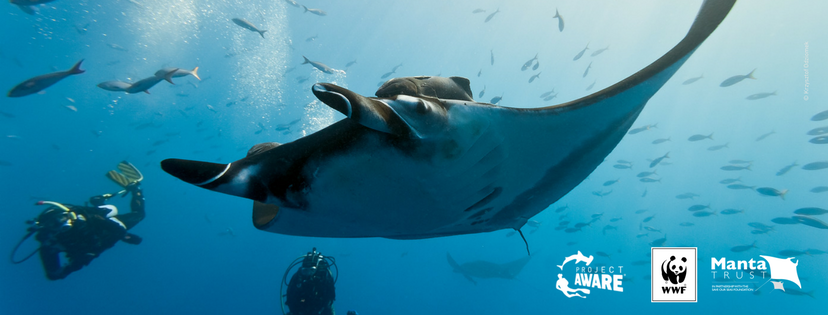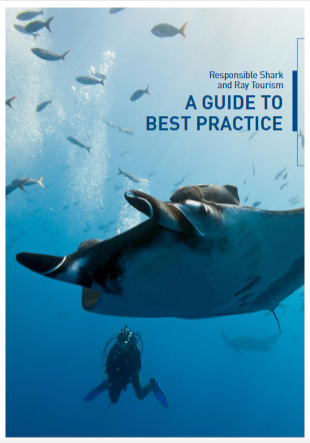How can conservation, tourism, research and community engagement work in partnership to help save sharks and rays?

Even though I have logged too many dives to keep count, almost none of them have been for recreational purposes. And definitely, in my early diving days as a commercial diver, none of them were with the animals that had drawn me to study marine biology in the first place. Sharks.
The shallow fringing coral reef systems of Fiji are blessed with numerous, easy to interact with sharks. My first few dives in the world of underwater tourist allowed me to get up close and personal with sleek and elegant blacktip reef, elongated and curious whitetip reef and the classic grey reef sharks. Being able to take time to look at my surroundings made diving a whole new experience again.
Fijian sharks, and their often overlooked cousins the rays, are a major draw for tourists to this particular set of islands. In 2011, an economic study estimated that shark divers contributed over US$42 million to Fiji’s economy. Similar studies indicated that reef sharks contribute more to Palau’s economy. Research papers such as these add credibility to the often heard claim that sharks are worth more alive than dead. And, while this might possibly be true for some limited species of sharks and rays, truly sustainable eco-tourism incorporates a lot more than the ability to generate income.
The topic of eco-tourism came up in discussions with colleagues from Project AWARE and the Manta Trust at an international meeting on shark and ray conservation. We sat down to discuss our own shark and ray diving experiences from around the world, and from the various stories that were shared, it became apparent that not every eco-tourism encounter was equal, and some operators put more emphasis on the “eco” part than others. We all had tales of great encounters and also some horror stories. We were aware, and our organizations have developed, various codes of conduct that existed around the world - from manta rays to whale sharks to cage diving with great white sharks. But we realised most of these consisted of basic information to minimise negative impacts on the animals and their habitats. They didn’t appear to contain much information on the science behind the shark and ray encounter nor did they touch on other, critical benefits that could be associated with responsible tourism. These early discussions shaped our idea to develop a compendium of best practices.
 My own experiences with operators in Fiji have certainly been more on the “eco” side, and I have been fortunate to see conservation, tourism, research and community engagement in action. Just down the road from my office is the small tourist town of Pacific Harbour, located on the south coast of the main island of Viti Levu. Pacific Harbour is a magnet for divers looking to experience an encounter with large bull sharks, and is also home to some very good examples of what constitutes best practices. In Beqa Lagoon, Shark Reef Marine Reserve was recently designated as Fiji’s first ever fully protected National Marine Reserve. This monumental achievement started out as a project to protect the sharks’ natural reef habitat. The dive operator, Beqa Adventure Divers, collaborated with the local communities to agree to a complete fishing moratorium on Shark Reef. In return for this, the operator donates a fee collected from divers entering Shark Reef to the local villages. Since the project started in 2003, it has shown a multitude of tangible benefits including increases in biodiversity, community development programmes and innovative shark research.
My own experiences with operators in Fiji have certainly been more on the “eco” side, and I have been fortunate to see conservation, tourism, research and community engagement in action. Just down the road from my office is the small tourist town of Pacific Harbour, located on the south coast of the main island of Viti Levu. Pacific Harbour is a magnet for divers looking to experience an encounter with large bull sharks, and is also home to some very good examples of what constitutes best practices. In Beqa Lagoon, Shark Reef Marine Reserve was recently designated as Fiji’s first ever fully protected National Marine Reserve. This monumental achievement started out as a project to protect the sharks’ natural reef habitat. The dive operator, Beqa Adventure Divers, collaborated with the local communities to agree to a complete fishing moratorium on Shark Reef. In return for this, the operator donates a fee collected from divers entering Shark Reef to the local villages. Since the project started in 2003, it has shown a multitude of tangible benefits including increases in biodiversity, community development programmes and innovative shark research.
When we started developing the guide, we knew that we must involve people working at the cutting edge of shark research and those at the grassroots of shark and ray tourism for best input and technical expertise. Dive industry experts helped provide robust, practical and constructive advice. For all those tireless responses to our endless exchanges, we are eternally grateful.
With the rise of consumer power via websites such as TripAdvisor, consumers reward business of their choice with their dollars thus influencing decisions made by tourism operators. Our guide is not meant to be used to assess individual operations (our good friend and colleague Rick Macpherson has developed a user friendly rating system). Instead, we hope it will be a source of information for operators to develop new shark and ray interaction sites or to improve existing ones. There are sections of the Guide outlining how to get involved in shark research, engaging with local communities and even tackling the contentious issue of using food to attract shark and rays.
Sharks and rays are facing increased risk of extinction. There is also a serious problem in many parts of the world with local data deficiency, even for some of the commonly encountered species known to divers. There is no magic “silver bullet” that will solve all the very serious threats of overfishing and habitat loss that sharks and rays face, but responsible tourism practices can certainly help.
You can download Responsible Shark & Ray Tourism: A Guide to Best Practice here.



